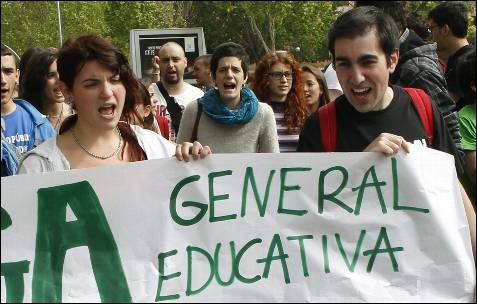In Britain, the number of teachers had increased by some 100,000 through the 1970s so that class sizes in state schools began to approach those in private schools. However during the 1980s the Thatcher government implemented many think tank policies, including reduced government spending. Her government reduced school funding in real terms by 10 percent between 1979 and 1986 and only allowed it to increase after 1988 to fund its educational ‘reforms’. Some 50,000 teachers were removed, against the trend in most other developed nations, and class sizes began to increase again, despite declining pupil numbers. Music and French classes, sport, and library facilities were cut. Schools sold off more than 5000 playing fields between 1981 and 1999 to make up for funding inadequacies.
Australian state and federal governments were also influenced by business and the corporate-funded think tanks to lower government spending and reduce budget deficits during the 1980s. Payments from the Commonwealth to the states fell and in the early 1990s state revenues from property taxes and financial transaction taxes also declined. As a result state governments cut educational expenditure causing class sizes to rise. Hundreds of public schools were closed and in the early 1990s “over 8000 teaching position were designated in excess of need”.
Public spending on school education declined from 5.9 percent of GDP in the mid 1970s to 2.7 percent of GDP at the turn of the century, despite the desire of a vast majority of voters that more be spent on schools. At the same time Australia’s school spending ranking fell to 15th out of 17 OECD countries.
Consequently there are schools around the country that are in a dilapidated state. In NSW, for example, whilst the government was spending $1.6 billion on the Olympic Games, school maintenance programmes were suspended leaving schools with blocked toilets, termite infestations, leaking rooves and other problems for years. This is despite polls which have demonstrated repeatedly that taxpayers would prefer more money was spent on education.
In Canada, total government spending on public education declined from the late 1990s. This was in response to government budget deficits created by large tax cuts that had been given to wealthy individuals and corporations. In Alberta school funding was cut by 12% over three years causing teachers salaries to decline. In Québec, the education budget was cut in terms of percentage of GDP by some $2.5 billion between 1992/3 and 2002/3.
In Ontario the New Democratic Party (NDP) government cut educational funding in 1993 in response to rising state debt and a budget deficit that they were unwilling to rectify with higher taxes. Further budget cuts were made by the Tory government in 1995, which adopted the corporate-preferred policy of low government spending and balanced budgets. School funding was cut by more than a billion dollars in three years causing a decline in educational quality that saw many parents moving their children to private schools.
By the start of the 21st century, the idea that high investment in education was beneficial had also disappeared in Europe. Business leaders had been calling for education funding cuts since the 1990s. The European Roundtable of Industrialists (ERT) wrote: “We have to use the limited amount of public money [for education] as a catalyst to sustain and stimulate the activity of the private sector”.
In 2003 European Commissioner for Education and Culture, Viviane Reding, claimed that the “economic situation does not permit further significant public money to be invested…”
 Following the Global Financial Crisis, when several European nations were facing budget crises, school education cuts were high on the agenda.
Following the Global Financial Crisis, when several European nations were facing budget crises, school education cuts were high on the agenda.
In Spain teachers’ wages have been reduced by 15% and some 60,000 jobs lost. The education ministry had its budget cut by 14% in 2012.
In Portugal around 15,000 school teachers lost their jobs during 2011 and 12. Nevertheless the International Monetary Fund (IMF) suggested “making the education system more flexible and limiting the state’s role as a supplier of education services” by eliminating 50,000 to 60,000 jobs.
In Greece, in 2011 over 20,000 "public school teachers retired or changed careers due to low wages and difficult working conditions—circumstances as bad as no wintertime heat. And despite this massive exodus of the workforce, the Education Ministry had funds to hire only about 3,500 new teachers, leaving more than 15,000 classrooms without teachers". The Ministry closed over a thousand schools and merged others so that they had larger classes and children had much further to travel to get to school.
Between 2010 and 2012, education cuts "of more than 5% were imposed in Greece, Hungary, Italy, Lithuania and Portugal, while Estonia, Poland, Spain and the UK (Scotland) saw decreases of 1 to 5%... teachers' salaries and allowances were reduced or frozen in 11 countries (Bulgaria, Croatia, Estonia, Greece, Hungary, Ireland, Italy, Latvia, Lithuania, Portugal and Spain)".
The Global Financial Crisis has also impacted severely on US schools with state revenue falling and most states cutting school funding as a consequence (see graph below). As a result 328,000 jobs were cut from the local government education sector between 2008 and 2013.

If you have any examples or updates you would like to contribute please email them to me and I will add them here. Please give references for where you sourced the information.